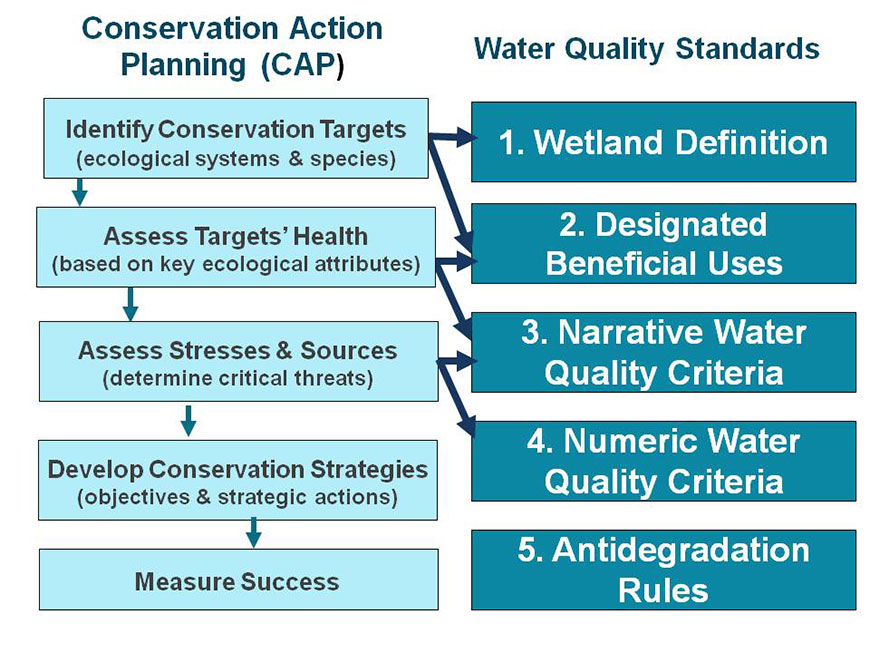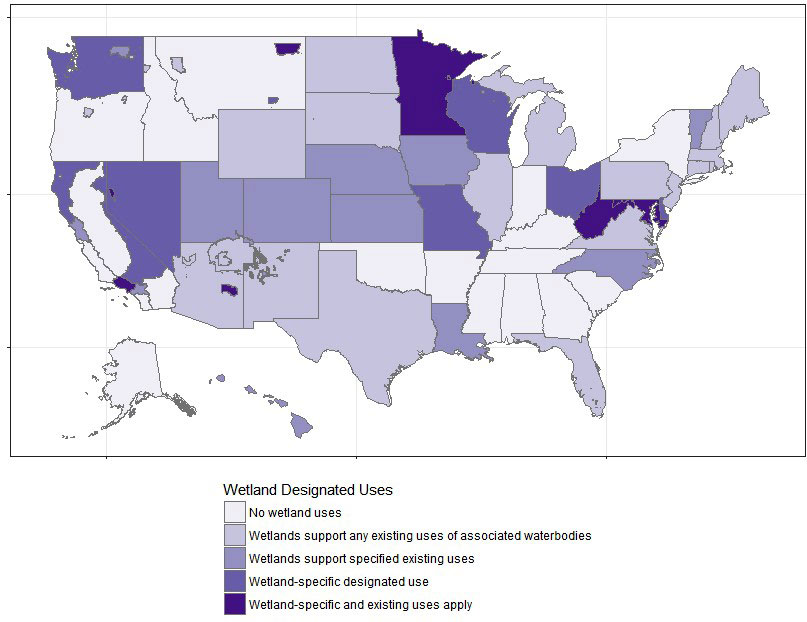
The goal of the Utah Department of Environmental Quality-Utah Division of Water Quality (UDWQ) FY16-FY17 Wetland Program Development Grant (WPDG) was to develop a designated use category and appropriate narrative criteria for Utah wetlands based on previously developed water resource and wetland planning tools. Two tasks were completed in support of this goal. First, Conservation Action Planning meetings gathered feedback from stakeholders on wetland classes to be included in water quality standards (WQS), measureable characteristics of those wetlands, and the major threats to wetlands. Second, UDWQ benchmarked Utah’s standards against those of other states, regions, and tribes to develop implementation strategies for updating Utah’s WQS based on stakeholder input and other state’s experiences.
The full report on the wetland water quality standards project can be found here:
Water quality standards (WQS) are goals for a body of water and have three main components: beneficial uses, criteria, and antidegradation. Designated beneficial uses specify the goals and expectations for how the water body is used. Water quality criteria describe the minimum level of water quality that must be maintained in order to protect the beneficial use. Numeric criteria specify the maximum concentration of specific pollutants allowable for a water body while narrative criteria describe the desired condition of a water body in terms of the unallowable pollution or ambient conditions to maintain.
The Clean Water Act requires states and tribes to establish WQS for all waters within their boundaries. For a variety of scientific, regulatory, and management reasons, WQS for wetlands have developed more slowly than for lakes and streams, most notably because of confusion about whether and which wetlands count as waters protected by the Clean Water Act and because highly variable conditions within wetlands that make establishing water quality criteria difficult. To help states develop WQS for their wetlands, the EPA has identified five steps to apply WQS to wetlands:
- Define wetlands as Waters of the State
- Designate uses for all wetlands
- Adopt aesthetic narrative and appropriate numeric criteria protective of wetland uses
- Apply biological criteria to assess wetlands are attaining their use
- Apply antidegradation policy and implementation methods to wetlands
Conservation Action Planning and Water Quality Standards
Conservation Action Planning (CAP) is a process developed by The Nature Conservancy to plan, develop, and implement conservation projects in a strategic and collaborative way. The CAP framework has five steps:
- Identify conservation targets (ecosystems or species)
- Assess conservation target health based on key ecological attributes
- Assess stress and sources that threaten target health
- Develop conservation strategies
- Measure success
The figure below illustrates how the CAP process can be used to develop water quality standards.

The Wetland Water Quality Standards CAP Workshops page details the process and results from meetings held in the spring of 2018.
Benchmarking WQS with Other States
GSL Wetland CAP meetings defined important wetland classes, the biological, physical, and chemical features that should be part of a wetland-specific designated use, and the conditions and stressors water quality criteria should protect against. Benchmarking current Utah WQS against the WQS of 81 states, regions, and tribes provided potential strategies to protect wetland ecosystems already in practice. WQS from 34 states, 5 water quality regions, and 42 tribes that address wetlands to some degree are summarized here.
Wetland WQS are in active development in many states. Because of this, we benchmarked not only the states with complete wetland WQS, but also with states in the initial stages of standard development as well as tribes in order to get a more comprehensive view of the strategies available for Utah. The sections below summarize Utah’s current water quality rules and the rules of other states and tribes.

The document linked below contains the relevant portions of all the state and tribal WQS included in benchmarking: definitions, designated uses, and narrative criteria.
- Appendix B. Wetland Water Quality Standards Benchmarking (2019) (10 MB)
Definitions – Waters of the State and Wetlands
The first step in the EPA’s guidance on wetland WQS is to define wetlands in state water quality rules. Utah’s definition of Waters of the State found in the Definitions and General Requirements section (R317-1) does not include the term wetlands, though it does include “marsh” and “pond,” which are common terms for two types of wetlands.
Waters of the state” means all streams, lakes, ponds, marshes, water-courses, waterways, wells, springs, irrigation systems, drainage systems, and all other bodies or accumulations of water, surface and underground, natural or artificial, public or private, which are contained within, flow through, or border upon this state or any portion thereof, except that bodies of water confined to and retained within the limits of private property, and which do not develop into or constitute a nuisance, or a public health hazard, or a menace to fish and wildlife, shall not be considered to be “waters of the state” under this definition (UAC R317-1-1).

Wetlands come in diverse types, from relatively deeply flooded submergent marshes to ephemerally flooded playas and mudflats. A definition of wetlands needs to be broad enough to cover all biological classifications of different wetland types and precise enough to be legally interpreted. The most common definition of wetlands included in benchmarking statutes is from the Code of Federal Regulations 40 CFR §116.3:
(iv)Wetlands. The term wetlands means those areas that are inundated or saturated by surface or groundwater at a frequency and duration sufficient to support, and that under normal circumstances do support, a prevalence of vegetation typically adapted for life in saturated soil conditions. Wetlands generally include swamps, marshes, bogs, and similar areas (Code of Federal Regulations, 1978).
Designated Beneficial Uses

Currently, Utah has five designated beneficial use categories: water source for domestic systems, recreational use and aesthetics, aquatic wildlife, agricultural use, and Great Salt Lake (Utah Administration Code (UAC) R317-2-6). Within those five categories are 14 subcategories of beneficial uses. Utah WQS apply designated beneficial uses to some wetlands according to geographic location or ownership as seen in the map to the left.
Wetlands provide many unique ecosystem services that can be protected or monitored through the use of a wetland-specific beneficial use. For example, providing habitat for wetland-dependent birds, attenuating floods, and improving downstream water quality are functions recognized in wetland-specific beneficial uses. Wetlands are also critical parts of watersheds, regulating the flow of water and nutrients between water bodies, and one of many aquatic ecosystems integral to the life cycle of aquatic organisms that travel between wetlands, streams, and lakes, which suggests that some existing designated uses for lakes and streams might be applicable to wetlands as well. States and tribes have addressed wetland designated uses in a variety of ways from applying existing stream and lake uses to wetlands or deriving uses specific to wetlands.

Thirty-nine states and tribes explicitly state that wetlands support the same uses as the water bodies they are adjacent to or associated with, rather than giving different uses to wetlands. While that approach does include wetlands within WQS, applying uses from other aquatic waters is a shaky proposition in wetlands, which have different water quality regimes than the water bodies they are associated with and it addresses only riparian waters, not isolated wetlands or large complexes of wetlands. Twenty-five states and tribes have specified which existing beneficial uses (uses that also apply to streams and lakes) are applicable to wetlands; Utah is among those states, where subcategories of recreation and aquatic life uses have been applied to some wetlands. Twenty states have developed wetland-specific beneficial uses; ten of those twenty also apply existing uses to wetlands in addition to their specific use.
Water Quality Criteria
Utah has a narrative standard applicable to all Waters of the State that prohibits degradation to aesthetics, the development of toxic conditions, and change to the biological community:
It shall be unlawful, and a violation of these rules, for any person to discharge or place any waste or other substance in such a way as will be or may become offensive such as unnatural deposits, floating debris, oil, scum or other nuisances such as color, odor or taste; or cause conditions which produce undesirable aquatic life or which produce objectionable tastes in edible aquatic organisms; or result in concentrations or combinations of substances which produce undesirable physiological responses in desirable resident fish, or other desirable aquatic life, or undesirable human health effects, as determined by bioassay or other tests performed in accordance with standard procedures; or determined by biological assessments in Subsection R317-2-7.3 (UAC R317-2-7.2).
Numeric criteria for bacteriological, physical, inorganic, and organic pollutants have been developed for the recreation and aquatic life uses that state and federally-managed wetlands support (UAC R317-2-14). However, aquatic life criteria contain footnote 2a which excludes applying aquatic life dissolved oxygen (DO) and pH criteria to GSL impounded wetlands until ecological integrity assessment methods have been developed (UAC R317-2- Table 2.14.2). Due to their dynamic hydrology (cycling between flooded and dry stages) and high biological productivity, conditions in wetland may naturally exceed water quality criteria developed for other aquatic ecosystems, especially criteria for pH, DO, and nuisance algae, yet failing to apply some numeric criteria may leave systems vulnerable to impacts from pollution. Narrative criteria are an option to protect water quality in complicated and dynamic ecosystems because they are broad enough to describe a range of acceptable natural conditions and address the types of stressors relevant to wetlands (like drought and physical modifications), rather than discrete pollutants.
As with establishing designated uses, states followed a number of strategies in developing narrative criteria for wetlands. A few states (n=9) have developed narrative standards specific to water body types like wetlands, lakes and streams. The majority of states and tribes (n=53) have a single narrative standard that applies to all waters of the state, including wetlands. Several states (n=17) have additional narrative criteria that apply only to wetlands, in addition to the criteria that apply to all state waters. Additional criteria may be included in the narrative or general criteria of the main water quality statute or in a separate wetland policy. Few states (n=6) identify only a subset of the larger state narrative standard that applies to wetlands.

Utah’s current narrative standard addresses the most common narrative criteria but could be updated to include wetland-specific criteria based on the issues identified in monitoring and assessment research, CAP workshops, and common criteria other states and tribes have developed. The biggest concerns in Utah wetlands that are not addressed by the current narrative standard are hydrologic alterations, invasive species, and eutrophication.
Upcoming work
The goal of conducting Wetland WQS CAP workshops and benchmarking against other states was to develop a single wetland-specific designated use applicable to all wetlands statewide and updated narrative criteria that will adequately protect wetland water quality. Currently, Utah has designated uses that apply to wetlands in close proximity to GSL and within state and federal wildlife management areas, which leaves approximately 80% of Utah’s wetland area without specified water quality rules.

